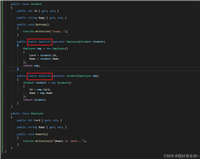可以通过多种方式实现集合的自定义排序。以下是一些常见的方法:
1. 使用 list<t>.sort 方法与自定义比较器
list<t> 类提供了一个 sort 方法,它允许传递一个 icomparer<t> 接口的实现来自定义排序逻辑。
using system;
using system.collections.generic;
public class person
{
public string name { get; set; }
public int age { get; set; }
}
public class personcomparer : icomparer<person>
{
public int compare(person x, person y)
{
// 按年龄升序排序
return x.age.compareto(y.age);
// 如果想按名字排序,可以这样做:
// return x.name.compareto(y.name);
// 或者,可以实现更复杂的排序逻辑
}
}
class program
{
static void main()
{
list<person> people = new list<person>
{
new person { name = "alice", age = 30 },
new person { name = "bob", age = 25 },
new person { name = "charlie", age = 35 }
};
people.sort(new personcomparer());
foreach (var person in people)
{
console.writeline($"{person.name}, {person.age}");
}
}
}
2. 使用 linq 的 orderby 方法与自定义键选择器
如果不需要就地排序(即不修改原始集合),而是想创建一个已排序的新集合,可以使用 linq 的 orderby 方法。可以传递一个键选择器函数来自定义排序逻辑。
using system;
using system.linq;
class program
{
static void main()
{
var people = new list<person>
{
new person { name = "alice", age = 30 },
new person { name = "bob", age = 25 },
new person { name = "charlie", age = 35 }
};
var sortedpeople = people.orderby(p => p.age).tolist();
foreach (var person in sortedpeople)
{
console.writeline($"{person.name}, {person.age}");
}
}
}
如果想按多个属性排序,可以使用 thenby 方法:
var sortedpeople = people.orderby(p => p.age).thenby(p => p.name).tolist();
3. 实现 icomparable<t> 接口
如果你的类本身就应该有一个默认的排序顺序,可以让该类实现 icomparable<t> 接口。这通常用于希望类的实例在任何情况下都按照相同的逻辑排序时。
public class person : icomparable<person>
{
public string name { get; set; }
public int age { get; set; }
public int compareto(person other)
{
if (other == null) return 1;
return this.age.compareto(other.age);
}
}
// 然后可以直接使用 sort 方法,不需要传递比较器
people.sort();
注意,实现 icomparable<t> 接口时也应该重写 object.equals 和 object.gethashcode 方法,以保持一致性,特别是在集合操作中(如使用哈希表时)。然而,对于排序目的,只实现 icomparable<t> 就足够了。
以上就是c#实现集合自定义排序的三种方式的详细内容,更多关于c#集合自定义排序的资料请关注代码网其它相关文章!






发表评论